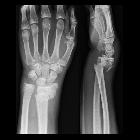proximal humeral fractures


















Proximal humeral fractures are common upper extremity fractures, particularly in older patients, and can result in significant disability.
Epidemiology
Proximal humeral fractures represent around 5% of all fractures . They are most common in older populations and especially in those who are osteoporotic. As with other injuries, there is a bimodal distribution with a small peak amongst the young.
The majority of proximal humeral fractures occur in the elderly (mean age 65 years) with ~70% occurring in women, presumably due to the greater incidence of osteoporosis . Most of these (90%) occur at home due to a fall, and in most cases they are an isolated injury .
Clinical presentation
Many older patients present following a relatively innocuous fall. Younger patients usually present following a high-trauma incident, e.g. a motor accident or fall from height. However, patients may present following a seizure, electrical shock or following direct trauma.
Pathology
Proximal humeral fractures usually result from a fall on an outstretched arm. Indirect forces transmitted through the proximal humerus and shoulder are the cause of most fractures. These forces may be compressive, tension, torsion or bending.
Radiographic features
Plain films are usually sufficient to characterize proximal humeral fractures, and thus to determine management. CT can be useful if adequate views cannot be obtained, if fractures are unusual or if other fractures (e.g. glenoid) are present . Additionally, CT (and especially 3D surface shaded reconstructions) has been shown to improve interobserver agreement on classification of proximal humeral fractures .
Regardless of the imaging performed, the number of displaced fragments should be assessed, to enable appropriate classification of the fracture (Neer classification or AO classification are most commonly used).
Radiograph
The fracture is usually evident as a lucency and cortical breach with variable degrees of angulation, impaction and displacement.
Reporting checklist
In addition to reporting the presence of a fracture, it is important to assess and comment on a number of other features.
- fracture: it should be noted that in most instances a description of the fracture rather than a specific classification is sufficient, but the features required to classify the fracture should be included
- location of fracture lines
- displacement and angulation of each part (>1 cm and >45 degrees respectively is particularly important in the Neer classification)
- presence of involvement of the articular surface
- associated injuries
Treatment and prognosis
Management depends not only on the type of fracture but also importantly on the functional status and living situation of the patient. For example, someone who lives alone may not be able to do so without the use of one arm.
Having said this, in almost all cases undisplaced fractures are treated conservatively, whereas operative open reduction and internal fixation (with a variety of intramedullary nails, plates and screws and K-wires) is reserved for displaced fractures . Hemi-arthroplasty is also an option especially for three and four-part fractures, where the risk of malunion and avascular necrosis are high .
In general, the prognosis is good with the majority of fractures healing well with little functional loss. Poor prognostic factors include :
- older age of patient
- displaced fracture
- three and four-part fractures (see Neer classification)
- type C fractures (AO classification)
Siehe auch:
- Colles-Fraktur
- Aseptische Knochennekrose
- Schulterluxation
- Osteoporose
- distale Radiusfraktur
- Einteilung proximale Humerusfraktur nach Neer
- Klavikulafraktur
- Frakturen der oberen Extremitäten
- AC-Gelenksprengung
- Humerusfraktur
- Head-Split-Fraktur proximaler Humerus
- Avulsionsfraktur Tuberculum minus humeri
- AO-Klassifikation
- AO-Klassifikation proximale Humerusfraktur
- Humeruskopffraktur
und weiter:
- hintere Schulterluxation
- radiologisches muskuloskelettales Curriculum
- AO classification of proximal humeral fractures
- Humerusschaftfraktur
- subkapitale Humerusfraktur
- fracture-dislocation of the humerus with intrathoracic displacement of the humeral head
- fracture surgical neck of the humerus
- einfache (juvenile) Knochenzyste Humerus
- non-united proximal humeral fracture

 Assoziationen und Differentialdiagnosen zu proximale Humerusfrakturen:
Assoziationen und Differentialdiagnosen zu proximale Humerusfrakturen:










